Rejuvenating Agents vs. Fluxing Agents: Their Respective Mechanisms of Action on Bitumen Subjected to Multiple Aging Cycles
Abstract
1. Introduction
2. Materials and Methods
2.1. Materials
2.2. Sample Preparation
2.3. Asphaltene Extraction (Deasphaltenization)
2.4. Rheological Analysis
- Temperature, 25–120 °C (increasing at the rate of 1 °C per min).
- Stress, 100 Pa.
- Parallel plate geometry, 25 mm diameter with a 2 mm gap.
- Frequency, 1 Hz.
2.5. Atomic Force Microscopy
2.6. Light Microscopy to Determine Asphaltene Melting Point
3. Results and Discussion
3.1. Rheological Properties
3.2. Morphological Properties
- i.
- The catana phase is made up of so-called bee structures, which resemble undulated wavy structures having a morphology of alternating swellings and depressions.
- ii.
- The peri phase is the domain surrounding the bee structures.
- iii.
- The para phase is dominant in bitumen’s matrix, flat in nature, and surrounds the peri phase.
- iv.
- The sal phase in combination with the para phase consists of aromatics and saturates, and these constitute the smooth matrix.
3.3. Light Microscopy to Determine Asphaltene Melting Point
3.4. Rejuvenating Effect vs. Fluxing Effect: Action Mechanism of Recycling Agents
4. Conclusions
- Dynamic shear rheology is fundamental in evaluating the mechanical properties of bitumen, and it often corroborates the results obtained from bitumen conventional tests. In fact, in this research, the conventional test results were also consistent with those of the DSR analysis. However, other techniques such as atomic force microscopy and light microscopy are very important in order to understand the mechanisms that govern the changes in bitumen’s properties upon aging, and the recycling of bitumen with rejuvenators or mere fluxing agents.
- The DSR results show that both recycling agents used in this study reduced the stiffness of the aged bitumen, recovering its mechanical properties close to that of the reference virgin bitumen. This was observed via both complex modulus and the transition temperatures. As mentioned earlier, these results are consistent with those obtained from the conventional bitumen tests, as expected.
- Via AFM, the R1 recycling agent was observed to restore the internal structural components of the aged bitumen, bringing it back to a structure very similar to the reference virgin bitumen. R2 recycling agent was only able to augment the maltenic fraction of the aged bitumen, merely softening it.
- Via deasphaltenization and light microscopy of asphaltenes, it is observed that R1 effectively recovered the properties of the corresponding bitumen by restoring its property of change of state in relation to temperature. This was not observed with R2, meaning that it has little to no effect on the asphaltenes of aged bitumen. Since aging is said to have a major effect on the properties of asphaltenes, it can be said that R2, in the real sense, does not reverse the effects of oxidation.
- Adding up the test results of this study and comparing their implications with what is written in the scientific literature on this topic, recycling agent R1 can be said to be a rejuvenator, while recycling agent R2 can be said to be a fluxing/softening agent. Accordingly, the introduced methods could be efficient techniques to differentiate the recycling agents into fluxing (softening) agents and rejuvenators.
Author Contributions
Funding
Institutional Review Board Statement
Informed Consent Statement
Data Availability Statement
Conflicts of Interest
References
- Bhanuprasad, K.; Raju, S.; Sarkar, A.K.; Singh, S.K.; Ravindranath, S. Performance of reclaimed asphalt pavement material in asphalt mixtures. In Proceedings of the 18th AAPA International Flexible Pavements Conference 2019, Sydney, Australia, 18–21 August 2019. [Google Scholar]
- Abe, A.A.; Oliviero Rossi, C.; Eskandarsefat, S.; Porto, M.; Loise, V.; Venturini, L.; Caputo, P. Reclaimed asphalt recycling agents: Looking into the blueprint of their mechanisms of action. In Construction and Building Materials; Elsevier: London, UK, 2023; Volume 363, p. 129843. ISSN 0950-0618. [Google Scholar] [CrossRef]
- Loise, V.; Oliviero Rossi, C.; Venturini, L.; Eskandarsefat, S.; Sangalli, L. Rejuvenating vs. softening agents; A rheological and microscopic study. In Proceedings of the 1st Macedonian Road Congress, Skopje, Macedonia, 7–8 November 2019; pp. 411–419. [Google Scholar]
- Yaseen, G.; Hafeez, I. Effect of cereclor as rejuvenator to enhance the aging resistance of reclaimed asphalt pavement binder. Materials 2020, 13, 1582. [Google Scholar] [CrossRef] [PubMed]
- Caputo, P.; Loise, V.; Crispini, A.; Sangiorgi, C.; Scarpelli, F.; Oliviero Rossi, C. The efficiency of bitumen rejuvenator investigated through Powder X-ray Diffraction (PXRD) analysis and T2-NMR spectroscopy. Colloids Surf. 2019, 571, 50–54. [Google Scholar] [CrossRef]
- Ashimova, S.; Teltayev, T.; Oliviero Rossi, C.; Caputo, P.; Eskandarsefat, S. Organic-based recycling agents for road paving applications in cold-climate regions. Int. J. Pavement Eng. 2020, 22, 1849–1857. [Google Scholar] [CrossRef]
- Bocci, E.; Mazzoni, G.; Canestrari, F. Ageing of rejuvenated bitumen in hot recycled bituminous mixtures: Influence of bitumen origin and additive type. Road Mater. Pavement Des. 2019, 20 (Suppl. 1), S127–S148. [Google Scholar] [CrossRef]
- De Bock, L.; Pierard, N.; Vansteenkiste, S.; Vanelstraete, A. Classification et Analyse des Produits Régénérants pour la Réutilisation des Enrobes; Dossier 21; BRRC: Brussels, Belgium, 2019; Available online: https://brrc.be/sites/default/files/2020-02/dossier21_fr.pdf (accessed on 11 March 2021).
- Caputo, P.; Eskandarsefat, S.; Porto, M.; Loise, V.; Oliviero Rossi, C.; Scarpelli, F.; di Santo, M.P.; Venturini, L. Towards advances in differentiating recycling agents: Softening agents vs. rejuvenating agents. In Proceedings of the 7th E&E Congress Eurashalt & Eurobitume, Virtual Conference, 15–17 June 2021. [Google Scholar]
- Chen, A.; Liu, G.; Zhao, Y.; Li, J.; Pan, Y.; Zhou, J. Research on the aging and rejuvenation mechanisms of asphalt using atomic force microscopy. Constr. Build. Mater. 2018, 167, 177–184. [Google Scholar] [CrossRef]
- Cavalli, M.C.; Zaumanis, M.; Mazza, E.; Partl, M.N.; Poulikakos, L.D. Effect of ageing on the mechanical and chemical properties of binder from RAP treated with bio-based rejuvenators. Compos. Part B Eng. 2018, 141, 174–181. [Google Scholar] [CrossRef]
- Caputo, P.; Oliviero Rossi, C. Differential scanning calorimetry as a new method to evaluate the effectiveness of rejuvenating agents in bitumens. Appl. Sci. 2021, 11, 6528. [Google Scholar] [CrossRef]
- Davidson, J.K. Progress in cold mix process in Canada. In Proceedings of the Canadian Technical Asphalt Association; Polyscience Publications: Morin Heights, QC, Canada, 2005; Volume 50, pp. 138–157. [Google Scholar]
- Tabatabaee, H.A.; Kurth, T.L. Analytical investigation of the impact of a novel bio-based recycling agent on the colloidal stability of aged bitumen. Road Mater. Pavement Des. 2017, 18 (Suppl. 2), 131–140. [Google Scholar] [CrossRef]
- Wang, J.; Buckley, J. Standard procedure for separating Asphaltenes from crude oils. Protocol PRRC 02-02. Available online: http://baervan.nmt.edu/groups/petrophysics/media/pdf/prrc_02-02.pdf (accessed on 13 December 2022).
- Nivitha, M.R.; Murali Krishnan, J. What is transition temperature for bitumen and how to measure it? Transp. Dev. Econ. 2016, 2, 1–8. [Google Scholar] [CrossRef]
- Loise, V.; Calandra, P.; Abe, A.A.; Porto, M.; Oliviero-Rossi, C.; Davoli, M.; Caputo, P. Additives on aged bitumens: What probe to distinguish between rejuvenating and fluxing effects. J. Mol. Liq. 2021, 339, 116742. [Google Scholar] [CrossRef]
- Lesueur, D. The colloidal structure of bitumen: Consequences on the rheology and on the mechanisms of bitumen modification. Adv. Colloid Interface Sci. 2009, 145, 42–82. [Google Scholar] [CrossRef] [PubMed]
- Pauli, A.T.; Branthaver, J.F.; Robertson, R.E.; Grimes, W.; Eggleston, C.M. Atomic force microscopy investigation of SHRP asphalts: Heavy oil and residue compatibility and stability. Prepr. Am. Chem. Soc. Div. Pet. Chem. 2001, 46, 104–110. [Google Scholar]
- Loeber, L.; Sutton, O.; Morel, J.V.J.M.; Valleton, J.M.; Muller, G. New direct observations of asphalts and asphalt binders by scanning electron microscopy and atomic force microscopy. J. Microsc. 1996, 182, 32–39. [Google Scholar] [CrossRef]
- Jäger, A.; Lackner, R.; Eisenmenger-Sittner, C.; Blab, R. Identification of microstructural components of bitumen by means of atomic force microscopy (AFM). PAMM Proc. Appl. Math. Mec. 2004, 4, 400–401. [Google Scholar] [CrossRef]
- Moir, M.E. Asphaltenes, what art thou? Asphaltenes and the Boduszynski Continuum. In The Boduszynski Continuum: Contributions to the Understanding of the Molecular Composition of Petroleum; ACS Symposium Series; American Chemical Society: Washington, DC, USA, 2018. [Google Scholar] [CrossRef]
- Hemmati-Sarapardeh, A.; Dabir, B.; Ahmadi, M.; Mohammadi, A.H.; Husein, M.M. Toward mechanistic understanding of asphaltene aggregation behavior in toluene: The roles of asphaltene structure, aging time, temperature, and ultrasonic radiation. J. Mol. Liq. 2018, 264, 410–424. [Google Scholar] [CrossRef]
- Wang, Y.; Zhao, K.; Li, F.; Gao, Q.; Lai, K.W.C. Asphaltenes in asphalt: Direct observation and evaluation of their impacts on asphalt properties. Constr. Build. Mater. 2021, 271, 121862. [Google Scholar] [CrossRef]
- Fischer, H.R.; Dillingh, E.C.; Hermse, C.G.M. On the microstructure of bituminous binders. Road Mater. Pavement Des. 2014, 15, 1–15. [Google Scholar] [CrossRef]
- Masson, J.F.; Leblond, V.; Margeson, J. Bitumen morphologies by phase-detection atomic force microscopy. J. Microsc. 2006, 221, 17–29. [Google Scholar] [CrossRef]
- Prosperi, E.; Bocci, E. A review on bitumen aging and rejuvenation chemistry: Processes, materials and analyses. Sustainability 2021, 13, 6523. [Google Scholar] [CrossRef]
- Tarpoudi Baheri, F.; Rico Luengo, M.; Schutzius, T.M.; Poulikakos, D.; Poulikakos, L.D. The effect of additives on water condensation on bituminous surfaces. In Proceedings of the RILEM International Symposium on Bituminous Materials (ISBM), Lyon, France, 14–16 December 2020. [Google Scholar]
- Yang, Z.; Zhang, X.; Zhang, Z.; Zou, B.; Zhu, Z.; Lu, G.; Xu, W.; Yu, J.; Yu, H. Effect of aging on chemical and rheological properties of bitumen. Polymers 2018, 10, 1345. [Google Scholar] [CrossRef]
- Garcia Cucalon, L.; King, G.; Kaseer, F.; Arambula Mercado, E.; Epps Martin, A.; Turner, F.T.; Glover, J.C. Compatibility of recycled binder blends with recycling agents: Rheological and physicochemical evaluation of rejuvenation and aging processes. Ind. Eng. Chem. Res. 2017, 56, 8375–8384. [Google Scholar] [CrossRef]
- Holleran, I.; Wilson, D.J.; Masad, E.; Holleran, G.; Alrashydah, E. Effect of bio-rejuvenator on recycled porous asphalt mixes. Road Mater. Pavement Des. 2021, 22, 1–27. [Google Scholar] [CrossRef]
- Chen, X.; Ning, Y.; Gu, Y.; Zhao, R.; Tong, J.; Wang, J.; Zhang, X.; Wen, W. Evaluating the rheological, chemical and morphological properties of SBS modified asphalt-binder under multiple aging and rejuvenation cycles. Appl. Sci. 2021, 11, 9242. [Google Scholar] [CrossRef]
- Grillia, A.; Iorio Gnisci, M.; Boccic, M. Effect of ageing process on bitumen and rejuvenated bitumen. Constr. Build. Mater. 2017, 136, 474–481. [Google Scholar] [CrossRef]
- Matolia, S.; Guduru, G.; Gottumukkala, B.; Kuna, K.K. An investigation into the influence of aging and rejuvenation on surface free energy components and chemical composition of bitumen. Constr. Build. Mater. 2020, 245, 118378. [Google Scholar] [CrossRef]
- Porto, M.; Angelico, R.; Caputo, P.; Abe, A.A.; Teltayev, B.; Rossi, C.O. The structure of bitumen: Conceptual models and experimental evidences. Materials 2022, 15, 905. [Google Scholar] [CrossRef]
- Shedid, S.A. An ultrasonic irradiation technique for treatment of asphaltene deposition. J. Pet. Sci. Eng. 2004, 42, 57–70. [Google Scholar] [CrossRef]
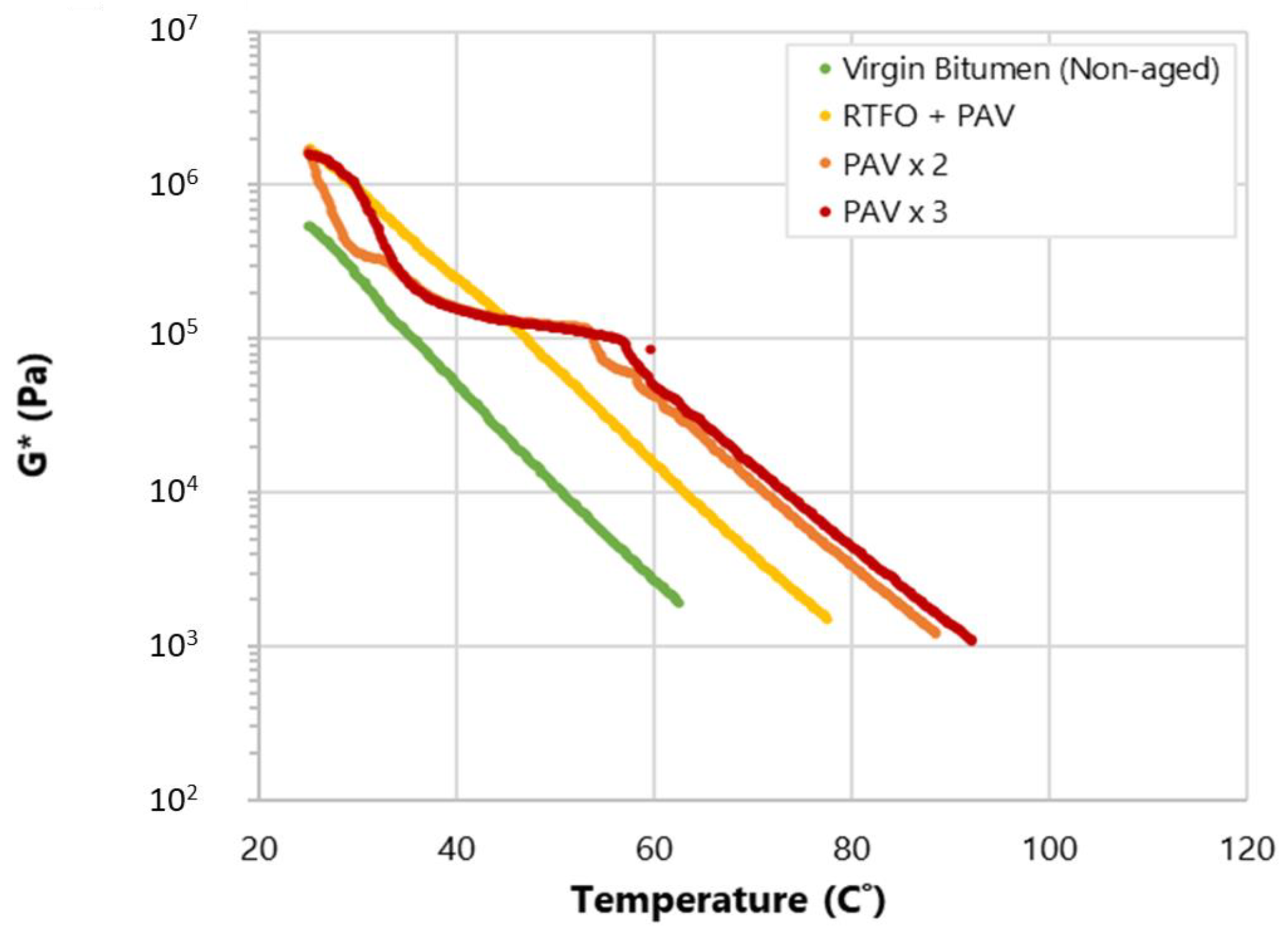
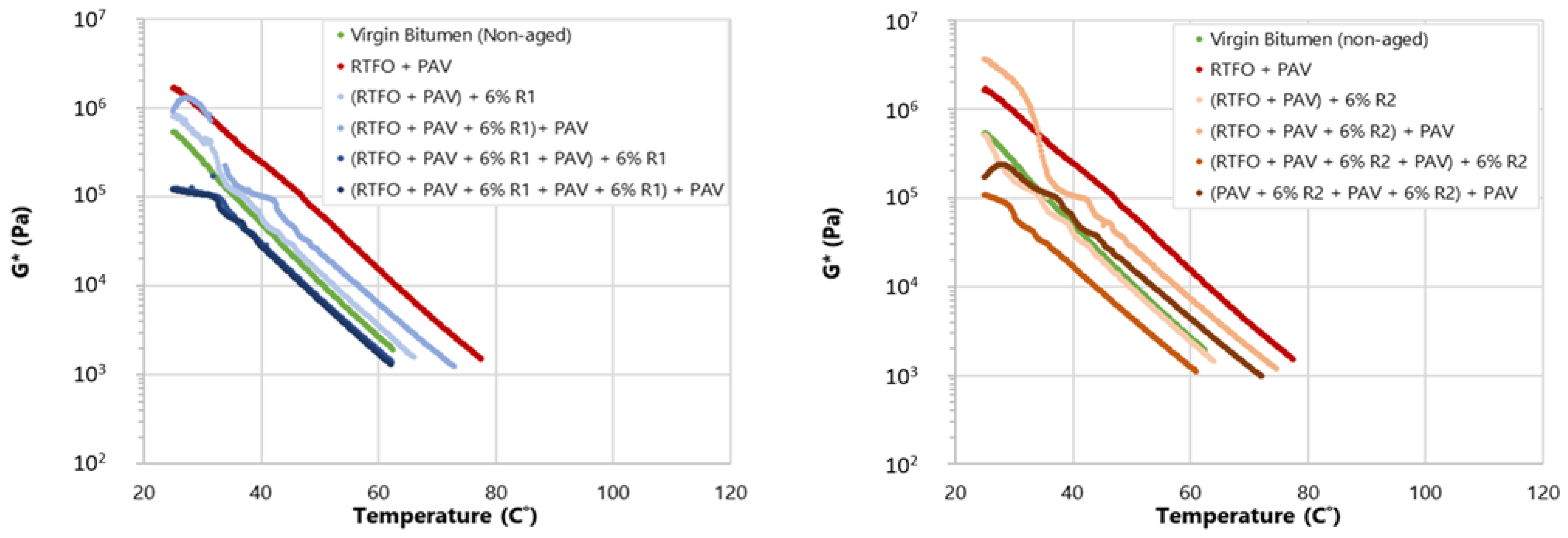
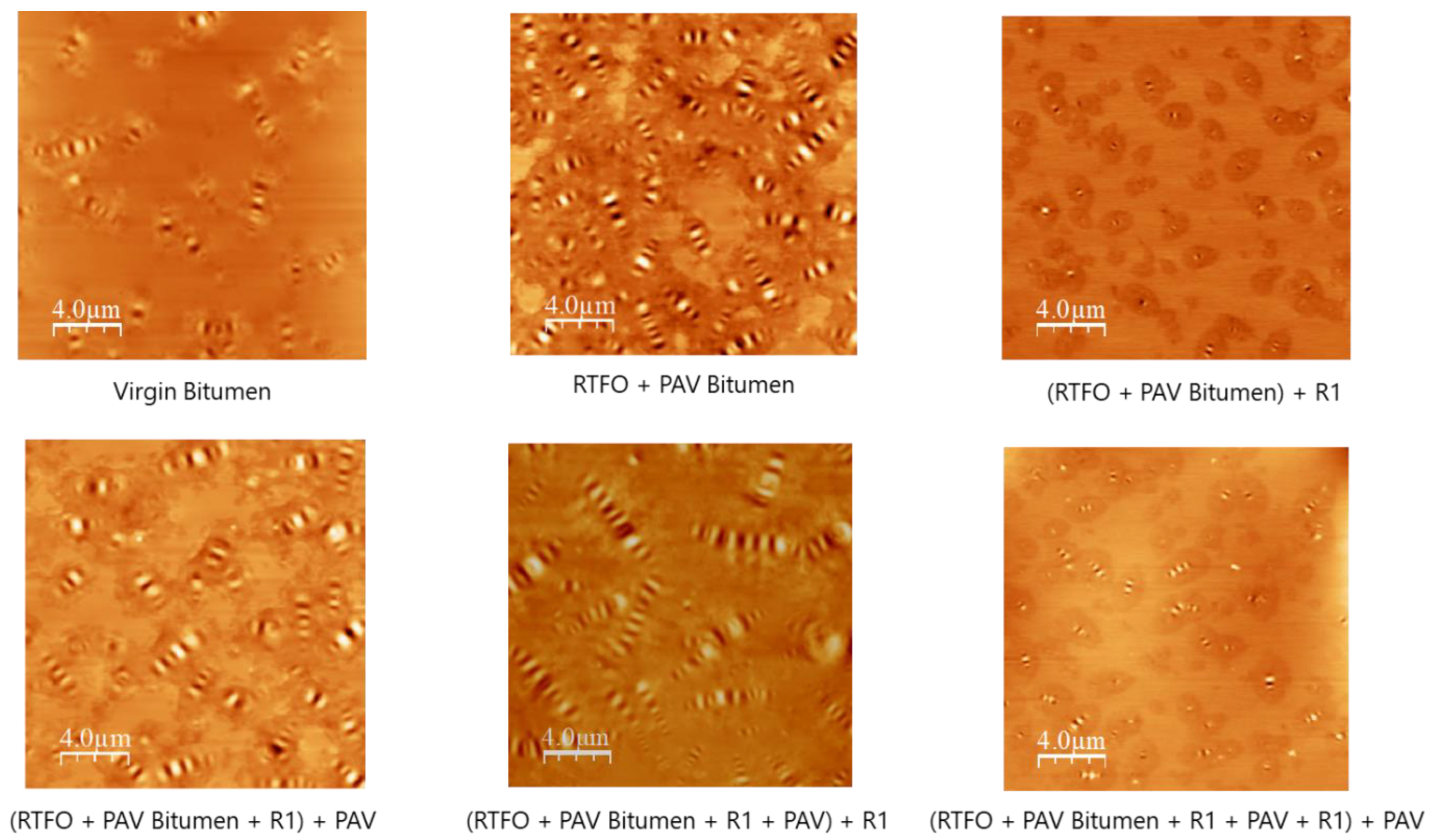

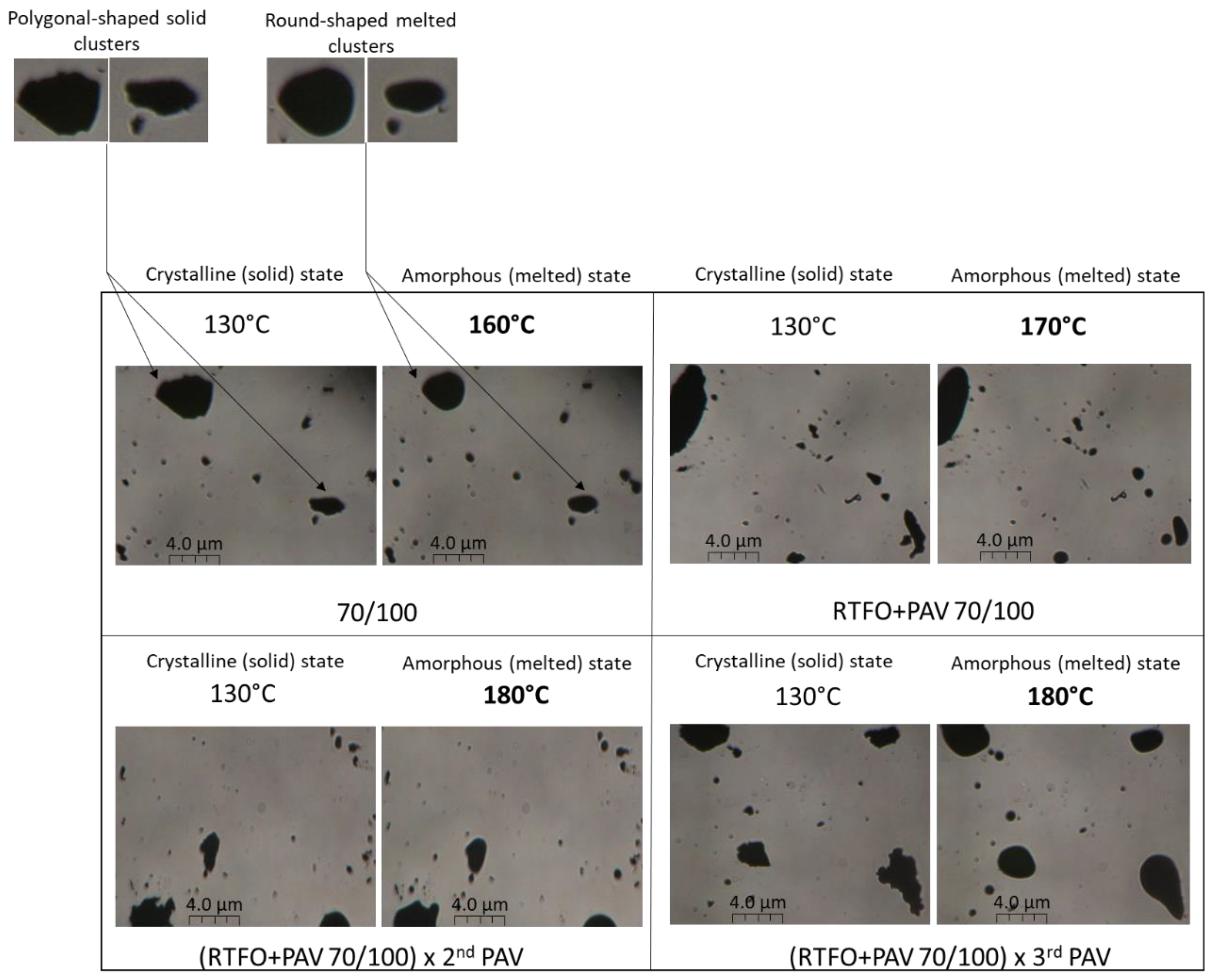
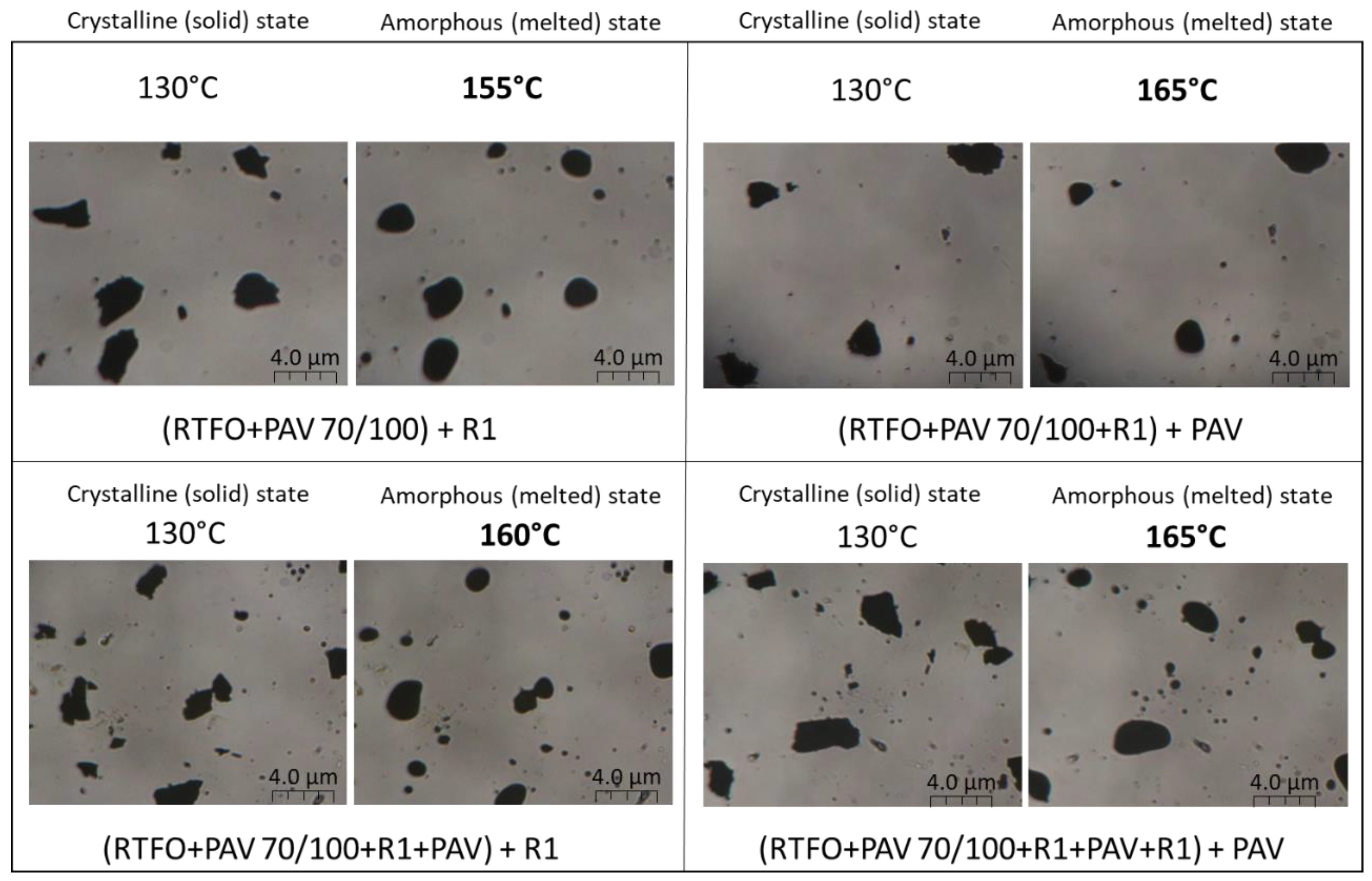
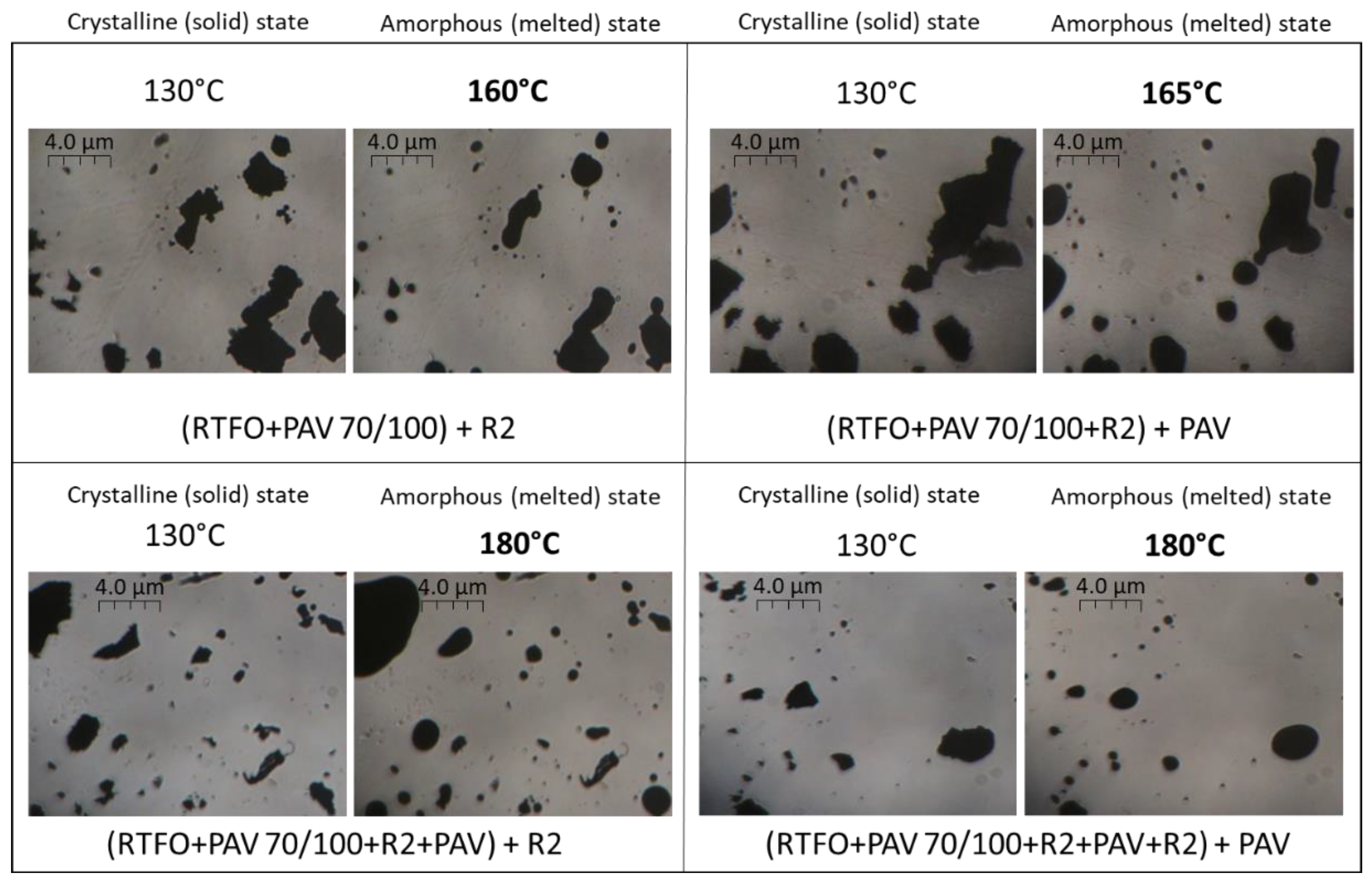
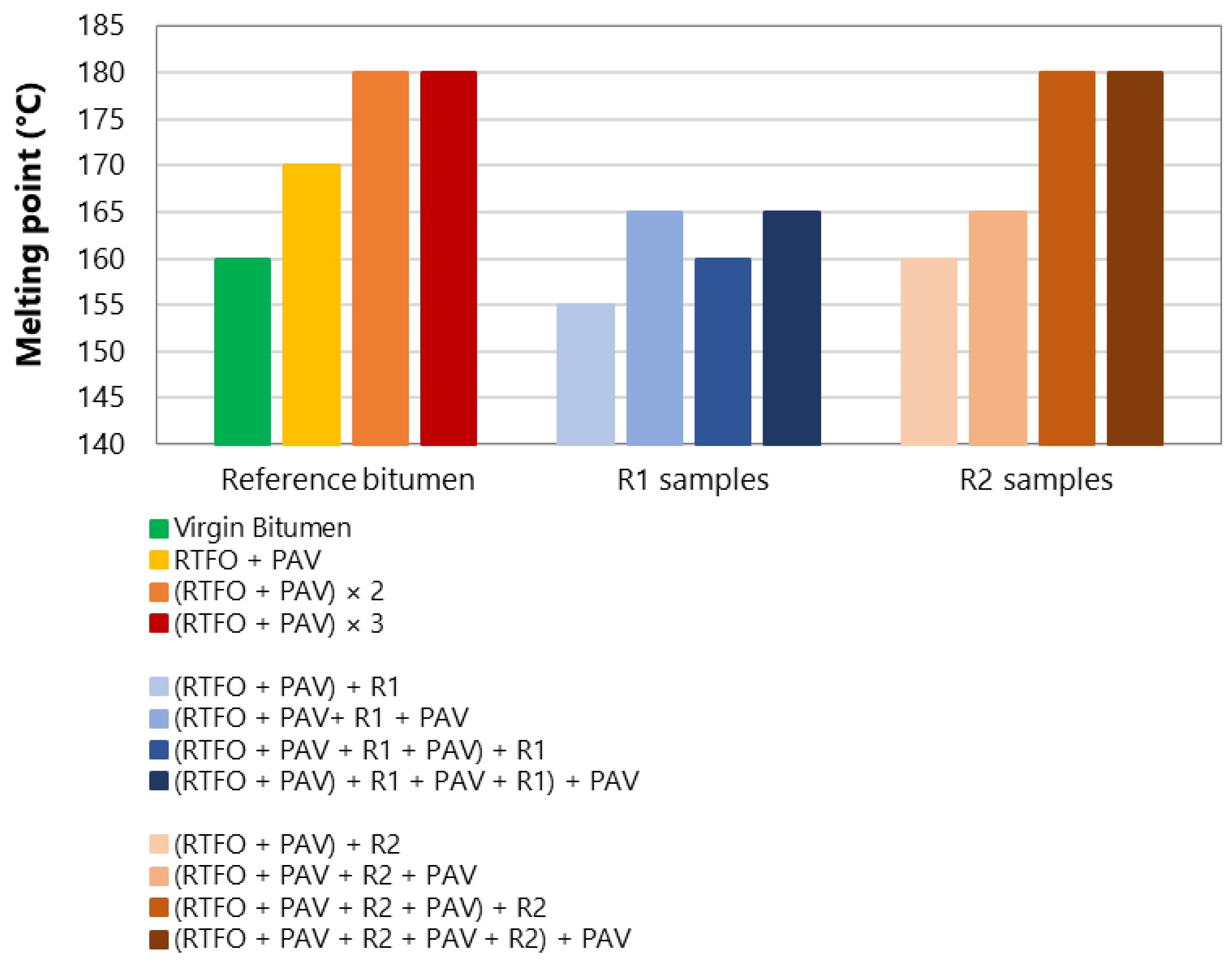
| Characteristic | Unit | Value | Method |
|---|---|---|---|
| Penetration @25 °C | dmm | 70–100 | EN 1426:2015 |
| Softening point | °C | 43–51 | EN 1427:2015 |
| Dynamic viscosity @135 °C | Pa.s | ≥0.23 | EN 13702:2018 |
| Flash point | °C | Min 250 | EN ISO 2592:2017 |
| Fraass breaking point | °C | Max −10 | EN 12593:2015 |
| Characteristic | Unit | Recycling Agent 1 (R1) | Recycling Agent 2 (R2) |
|---|---|---|---|
| Aspect | - | Liquid | Liquid |
| Color | - | Yellow | Yellow |
| Viscosity | cP | 25–50 | 20–30 |
| Pour point | °C | ≤−5 | ≤0 |
| Chemical nature | - | Mix of amino derivatives | Blend of vegetable esters |
| Testing Step | Testing Bitumen |
|---|---|
| 1 | Virgin bitumen |
| 2 | RTFO + PAV bitumen |
| 3 | (RTFO + PAV bitumen) + Ri |
| 4 | (RTFO + PAV bitumen + Ri) + PAV |
| 5 | (RTFO + PAV bitumen + Ri + PAV) + Ri |
| 6 | (RTFO + PAV bitumen + Ri + PAV + Ri) + PAV |
| Sample | Penetration (dmm) | Softening Point (°C) | Dynamic Viscosity (Pa·s) | |
|---|---|---|---|---|
| ID | 25 °C | - | 100 °C | 135 °C |
| Virgin bitumen | 76 | 44.8 | 11.4 | 1.2 |
| RTFO + PAV Bitumen | 51 | 57.5 | 38.8 | 2.6 |
| (RTFO + PAV Bitumen) × 2nd PAV | 38 | 66.5 | 68.5 | 4.0 |
| (RTFO + PAV Bitumen) × 3rd PAV | 28 | 75.8 | 141.6 | 5.7 |
| (RTFO + PAV Bitumen) + R1 | 74 | 46.0 | - | - |
| (RTFO + PAV Bitumen) + R2 | 75 | 44.2 | 6.4 | 0.8 |
| (RTFO + PAV Bitumen + R1) + PAV | 70 | 52.8 | - | - |
| (RTFO + PAV Bitumen + R2) + PAV | 74 | 44.6 | - | - |
| (RTFO + PAV Bitumen + R1 + PAV) + R1 | 72 | 43.3 | - | - |
| (RTFO + PAV Bitumen + R2 + PAV) + R2 | 80 | 41.8 | 8.0 | 0.8 |
| (RTFO + PAV Bitumen + R1 + PAV + R1) + PAV | 78 | 41.4 | 7.3 | 0.8 |
| (RTFO + PAV Bitumen + R2 + PAV + R2) + PAV | 68 | 52.6 | 11.5 | 1.1 |
Disclaimer/Publisher’s Note: The statements, opinions and data contained in all publications are solely those of the individual author(s) and contributor(s) and not of MDPI and/or the editor(s). MDPI and/or the editor(s) disclaim responsibility for any injury to people or property resulting from any ideas, methods, instructions or products referred to in the content. |
© 2023 by the authors. Licensee MDPI, Basel, Switzerland. This article is an open access article distributed under the terms and conditions of the Creative Commons Attribution (CC BY) license (https://creativecommons.org/licenses/by/4.0/).
Share and Cite
Abe, A.A.; Caputo, P.; Eskandarsefat, S.; Loise, V.; Porto, M.; Giorno, E.; Venturini, L.; Oliviero Rossi, C. Rejuvenating Agents vs. Fluxing Agents: Their Respective Mechanisms of Action on Bitumen Subjected to Multiple Aging Cycles. Appl. Sci. 2023, 13, 698. https://doi.org/10.3390/app13020698
Abe AA, Caputo P, Eskandarsefat S, Loise V, Porto M, Giorno E, Venturini L, Oliviero Rossi C. Rejuvenating Agents vs. Fluxing Agents: Their Respective Mechanisms of Action on Bitumen Subjected to Multiple Aging Cycles. Applied Sciences. 2023; 13(2):698. https://doi.org/10.3390/app13020698
Chicago/Turabian StyleAbe, Abraham A., Paolino Caputo, Shahin Eskandarsefat, Valeria Loise, Michele Porto, Eugenia Giorno, Loretta Venturini, and Cesare Oliviero Rossi. 2023. "Rejuvenating Agents vs. Fluxing Agents: Their Respective Mechanisms of Action on Bitumen Subjected to Multiple Aging Cycles" Applied Sciences 13, no. 2: 698. https://doi.org/10.3390/app13020698
APA StyleAbe, A. A., Caputo, P., Eskandarsefat, S., Loise, V., Porto, M., Giorno, E., Venturini, L., & Oliviero Rossi, C. (2023). Rejuvenating Agents vs. Fluxing Agents: Their Respective Mechanisms of Action on Bitumen Subjected to Multiple Aging Cycles. Applied Sciences, 13(2), 698. https://doi.org/10.3390/app13020698










